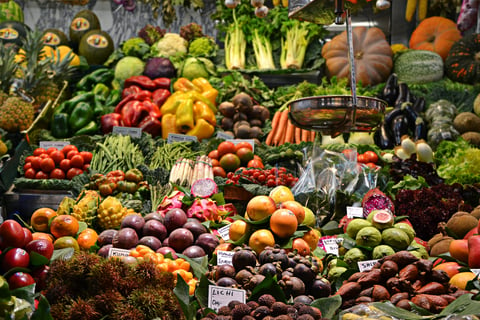If you’re a vegan, you’ve probably heard this:

Getting your daily dose of protein from a vegan diet is easier than you think. With a few mindful inclusions, you can ensure that your diet is as healthy as it should be.
So, why do we need protein?
Protein is the quintessential nutrient that each cell of our body needs to repair and grow. In addition to this, the antibodies that our body needs to protect itself from diseases, the enzymes needed for digestion and metabolism, and some hormones like insulin are all forms of proteins.
All foods, except oils and pure sugar, contain some amount of protein. But the quality of that protein depends on the amino acids the food provides. There are nine essential amino acids in total. Animal proteins contain all nine amino acids. Plant proteins (except Soy which contains all nine) lack one or more of these amino acids. So, when planning your meals, add variety to your diet to make up for the amino acids that may be missing. For example, grains have high methionine (a type of amino acid) but lack lysine, and dried beans and legumes are high in lysine but lack methionine. So, when your diet contains both grains and legumes, you get all the essential amino acids.
For a properly balanced meal, 10-12% of our calories should come from proteins.

How much protein do you need?
Healthy adults require 0.36 g per pound (or 0.8 g per kg) of their body weight per day.
So, if you weigh 154 lbs (70 kgs), you would require 154 x 0.36 (or 70 x 0.8)= 56 g of protein per day.
With this easy formula, you can plan your meals to ensure you are getting the amount of protein your body needs.
Fun fact: If you’re feeling lethargic or just can’t seem to make your brain work, eat something that's high in protein. It’ll stimulate your mind, help you focus and be at the top of your game!

Sources of plant-based protein
Beans and legumes
Beans and legumes are excellent sources of protein. Hummus, chili, and Indian dal are some of the ways you can include them in your diet. To add variety to your meals, look out for different varieties of both beans and legumes and experiment with recipes. Try making your next batch of hummus with black chickpeas or red lentils (masoor dal).
If you haven’t already, you can swap your flours for lentil or chickpea alternatives. Start off with these 45 recipes you can make using chickpea flour!
 Click here for the recipe to make these colorful chickpea pitas at home.
Click here for the recipe to make these colorful chickpea pitas at home.
Grains
High-protein grains include cornmeal, Kamut (wheat berries), teff, quinoa, whole-wheat pasta, wild rice, millet, couscous, oatmeal, and buckwheat. One cup of cooked whole grains provides between 6-20% of your daily value of protein. You can add more grains to your meals by making delicious grain bowls. Top your bowl of grains with lentils, veggies, tofu, seeds - the possibilities are endless! Try these healthy grain bowl recipes by the Simple Veganista for inspiration.
 Click here for the recipe to make delicious buckwheat pancakes at home.
Click here for the recipe to make delicious buckwheat pancakes at home.
Nuts
Most nuts contain a high amount of protein. However, with the exception of peanuts, most lack lysine. To counter this it’s best to combine them with legumes. Look for recipes like walnut and kidney bean spread or bean cassoulet with nut crumbs.
An excellent way to include nuts in your diet is by keeping a nut butter handy in your pantry. You can either make your own or buy some. So, when you're feeling a bit peckish, just top up your toast or bowl of granola with nut butter and instantly up your protein. According to research conducted by Purdue University, when people ate peanuts or any peanut butter snack, their hunger was satiated for up to two and a half hours! (For other snacks, it’s usually half an hour.) So, along with other health benefits, it could also help stop those unhealthy snacking habits!
 Click here to view this Christmas granola recipe and add more nuts and seeds in your diet.
Click here to view this Christmas granola recipe and add more nuts and seeds in your diet.
Edamame and soy
Soy is the most complete source of protein as it contains all amino acids. You can consume this fresh in the form of edamame or opt for tofu, soy chunks, soy milk, or tempeh.
You can start your day with a protein-packed breakfast of scrambled tofu, spice up your meals with this soya chunks kurma, consider making sides like this edameme dip, or indulge in this chocolate mousse using silken tofu.
Since this is such a versatile ingredient, the internet abounds with recipes!
 Click to view and try our chickpea tofu scramble recipe.
Click to view and try our chickpea tofu scramble recipe.
Seitan
Seitan is an excellent source of protein; it also closely resembles the texture of meat when cooked. So, for those of you who miss meat, or feel like recreating your favorite meat dishes, you can use seitan instead. You can buy seitan from stores or try making it at home. Experiment by making smoky seitan kebabs, gyros, or the classic Philly "cheese" sandwich.
 @beatrizmap's review of Seitan a la Plancha
@beatrizmap's review of Seitan a la Plancha
Get Your Protein!
Getting your recommended daily protein is easy, just ensure you're eating a balanced diet. Here's an idea of how you can plan ahead and look at your current diet, making simple swaps to reach your protein goals.
















